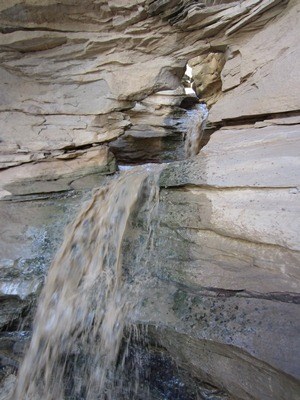
NPS Photo by Phil Varela During the Late Cretaceous, the sediments were deposited at sea level. Subsequent uplift due to mountain building processes rose what is now the Colorado Plateau to present day elevations. Between 40,000 and 70,000 years ago, Chaco Canyon was eroded by ancient waterways to expose the Menefee Formation. Since that time, the canyon has re-filled with 38 meters (125 feet) of alluvium, which form the modern valley floor. The Menefee Formation is less resistant to erosion than the Cliff House Formation and often completely erodes from beneath the younger sandstone. The unsupported sandstone will then break away in large slabs and boulders as the undercutting reaches joints and local weaknesses. This step-wise erosion is responsible for producing the prominent cliff faces in Chaco Canyon as well as the debris mounds or talus slopes piled against them. When this erosional process continues from several directions, it may actually "sever" a landform into separate segments and produce large, apparently free standing rock masses. Fajada Butte was "severed" from Chacra Mesa over the last 10,000 years by just such a process of gradual erosion. 
NPS Photo One of the most dramatic examples of step-wise erosion and undercutting of the massive sandstone blocks is the immense slab of sandstone known as "Threatening Rock." When the Chacoan builders began constructing Pueblo Bonito, "Threatening Rock" rested in a precarious position just behind it. Aware of the danger that it posed, the Chacoans built an earth, masonry, and log retaining wall beneath this massive rock slab. This slab was first described in 1901 and was referred to as the "Elephant." The Navajos called it "Braced-up Cliff," and the Park Service staff named it "Threatening Rock." In an attempt to predict the fall of "Threatening Rock," the Park Service took on the job of monitoring its movement. However, there was very little that could be done to prevent its fall, and on January 22, 1941 "Threatening Rock" collapsed, taking over thirty rooms in Pueblo Bonito with it. This was an extraordinary instance where the geologic processes that shaped the canyon over millennia were observed by people in historic times. Rapid occurrences, like rock falls, floods, and earthquakes redistribute earth and rock. The landscape continues to be reshaped after millions of years and, although we don't always observe it, soil and rock are constantly on the move through the processes of weathering, erosion, gravity, and the lateral movement of the earth's continents and ocean floors. |
Last updated: December 13, 2025
